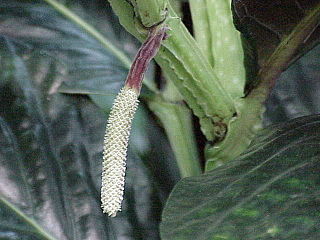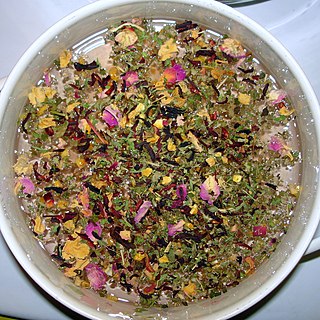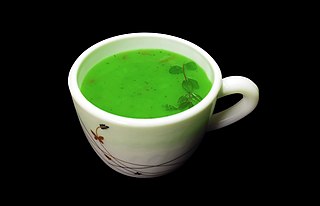
Triphala ("three fruits") is an Ayurvedic herbal rasayana formula consisting of 1:2:3 parts of three herbs i.e Haritaki:Bibhitaki:Amlaki.. It contains vitamin C. [1] [2]

Triphala ("three fruits") is an Ayurvedic herbal rasayana formula consisting of 1:2:3 parts of three herbs i.e Haritaki:Bibhitaki:Amlaki.. It contains vitamin C. [1] [2]

Piper, the pepper plants or pepper vines, is an economically and ecologically important genus in the family Piperaceae.

Herbal teas, also known as herbal infusions and less commonly called tisanes, are beverages made from the infusion or decoction of herbs, spices, or other plant material in hot water; they do not usually contain any true tea. Often herb tea, or the plain term tea, is used as a reference to all sorts of herbal teas. Many herbs used in teas/tisanes are also used in herbal medicine and in folk medicine. Some herbal blends contain true tea.

Ayurveda is an alternative medicine system with historical roots in the Indian subcontinent. It is heavily practiced throughout India, Nepal, Bangladesh, Pakistan and Sri Lanka, where as much as 80% of the population report using ayurveda. The theory and practice of ayurveda is pseudoscientific; some ayurvedic medicines have been found to contain toxic substances.

Herbal medicine is the study of pharmacognosy and the use of medicinal plants, which are a basis of traditional medicine. With worldwide research into pharmacology, some herbal medicines have been translated into modern remedies, such as the anti-malarial group of drugs called artemisinin isolated from Artemisia annua, a herb that was known in Chinese medicine to treat fever. There is limited scientific evidence for the safety and efficacy of many plants used in 21st-century herbalism, which generally does not provide standards for purity or dosage. The scope of herbal medicine sometimes includes fungal and bee products, as well as minerals, shells and certain animal parts.

Medicinal plants, also called medicinal herbs, have been discovered and used in traditional medicine practices since prehistoric times. Plants synthesize hundreds of chemical compounds for various functions, including defense and protection against insects, fungi, diseases, and herbivorous mammals.
In early ayurvedic medicine, rasāyana is one of the eight areas of medicine in Sanskrit literature. In Vedic alchemy, "rasa" also means "metal" or "a mineral".

The European Medicines Agency (EMA) is an agency of the European Union (EU) in charge of the evaluation and supervision of pharmaceutical products. Prior to 2004, it was known as the European Agency for the Evaluation of Medicinal Products or European Medicines Evaluation Agency (EMEA).
A carminative, known in Latin as carminativum, is a herb or preparation intended to either prevent formation of gas in the gastrointestinal tract or facilitate the expulsion of gas from the gastrointestinal tract, thereby combatting flatulence.

Terminalia bellirica, known as baheda, bahera, behada, beleric or bastard myrobalan, Persian بلیله (Balileh), Sanskrit: Vibhītaka बिभीतक, Aksha अक्ष) is a large deciduous tree in the Combretaceae family. It is common on the plains and lower hills in South and Southeast Asia, where it is also grown as an avenue tree. The basionym is Myrobalanus bellirica Gaertn.. William Roxburgh transferred M. bellirica to Terminalia as "T. bellerica (Gaertn.) Roxb.". This spelling error is now widely used, causing confusion. The correct name is Terminalia bellirica (Gaertn.) Roxb.

Susan Wittig Albert, also known by the pen names Robin Paige and Carolyn Keene, is an American mystery writer from Vermilion County, Illinois, United States. Albert was an academic and the first female vice president of Southwest Texas State University before retiring to become a fulltime writer.

Herbal Essences is a brand of hair care products line by Procter & Gamble. The brand was founded in 1971 as the single shampoo Clairol Herbal Essence Shampoo. There are 29 collections of varying hair care products, each designed to have a different effect on the user's hair.

Hemidesmus indicus, Indian sarsaparilla, is a species of plant found in South Asia. It occurs over the greater part of India, from the upper Gangetic plain eastwards to Assam and in some places in central, western and South India.
Herbal cigarettes are cigarettes that usually do not contain any tobacco or nicotine, instead being composed of a mixture of various herbs and/or other plant material. However, Chinese herbal cigarettes contain tobacco and nicotine with herbs added, unlike European and North American herbal cigarettes which have tobacco and nicotine omitted. Like herbal smokeless tobacco, they are often used as a substitute for standard tobacco products. Herbal cigarettes are often advertised as a smoking cessation aid. They are also used in acting scenes by performers who are non-smokers, or where anti-smoking legislation prohibits the use of tobacco in public spaces. Herbal cigarettes can carry carcinogens.

Siddha medicine is a form of traditional medicine originating in southern India. It is one of the oldest systems of medicine in India.
In Ayurvedic medicine rasaśāstra(रसशास्त्र), refers to processes by which various metals, minerals and other substances, including most notably mercury, are purified and combined with herbs in an attempt to treat illnesses. Rasaśāstra is a pharmaceutical branch of Indian system of medicine which mainly deals with the metals, minerals, product of animal origin, toxic herbs and their use in therapeutics.
Baidyanath Group is an Ayurvedic pharmaceutical company in India.
Drakshasava is a traditional Ayurvedic tonic made from grapes. Drakshasava is a weak wine because the grape juice is usually only partially fermented. It is also sometimes prepared by using raisin concentrate. The tonic is claimed to be beneficial for maladies such as lethargy, weakness and heat exhaustion. Drakshasava is believed to address health imbalances arising from an excess of the Vata-Vayu Dosha and is said to be useful in curing cardiac disorders and hemorrhoids in the Ayurvedic system.
Churna is a mixture of powdered herbs and or minerals used in Ayurvedic medicine. Triphala is an example of a classic Ayurvedic formula, used for thousands of years that is made from the powders of three fruits Amalaki, Haritaki and Bibhitaki.

Brigada Mass Media Corporation (BMMC) is a newspaper company and media network in the Philippines. It is the first-ever local Tri-media organization to have emerged from the Soccsksargen area as a national network with its array of Brigada News FM stations. BMMC is part of Brigada Group of Companies of entrepreneur Elmer Catulpos which also maintains three newspaper editions in Mindanao, one TV station, distribution of herbal food supplements, medicines, cosmetics and engine care products, a drug pharmacy, a garden resort and two private security agencies.

Kola kanda is a traditional herbal congee or gruel made from raw rice, coconut milk and the fresh juice of medicinally valued leafy greens.